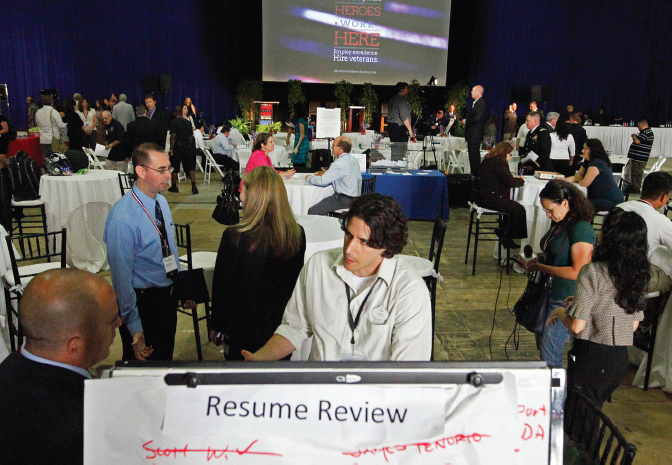UNDERSTANDING RÉSUMÉS.
Want to get a job?
UNDERSTANDING RÉSUMÉS. The point of a résumé is to provide a quick, easy-
Résumés do vary enormously in design — though they often resemble outlines without the numbers or letters. You have to decide on everything from fonts and headings to alignments and paper. You can pay companies to craft your résumé or use widely available templates to design it and then post it online. But your word processor has all the power you need to create a competent résumé on your own. Here’s some advice.

At a Walt Disney Company job fair for returning veterans, experts help vets polish their résumés.
Associated Press/Reed Saxon.
Gather the necessary information. You’ll have to collect this career data sooner or later. It’s much simpler if you start in college and gradually build a full résumé. Don’t guess or rely on memory for résumé information: Get the data right. Verify your job titles and your months or years of employment; give your major as it is identified in your college catalog; make an accurate list of your achievements and activities without embellishing them. Don’t turn an afternoon at a sandlot into “coaching high school baseball.” Focus on attainments during your college years and beyond. Grade school and high school achievements don’t mean much, unless you’re LeBron James.
Decide on appropriate categories. Contrary to what you may think, there’s no standard form for résumés, but they do usually contain some mix of the following information:
 Basic contact data or heading: your name, address, phone number, and e-
Basic contact data or heading: your name, address, phone number, and e-mail address  Educational attainments (usually college and above, once you have a BA, BS, or other postsecondary credential): degrees earned, where, and when
Educational attainments (usually college and above, once you have a BA, BS, or other postsecondary credential): degrees earned, where, and when Work experience: job titles, companies, and dates of employment, with a brief list of skills you used in specific jobs (such as customer service, sales, software programs, language proficiencies, and so on)
Work experience: job titles, companies, and dates of employment, with a brief list of skills you used in specific jobs (such as customer service, sales, software programs, language proficiencies, and so on) Other accomplishments: extracurricular activities, community service, volunteer work, honors, awards, and so on. These may be broken into subcategories.
Other accomplishments: extracurricular activities, community service, volunteer work, honors, awards, and so on. These may be broken into subcategories.
Depending on the situation, you might also include the following elements:
 A brief statement of your career goals
A brief statement of your career goals A list of people willing to serve as references (with their contact information)
A list of people willing to serve as references (with their contact information)
You can add categories to a résumé too, whenever they might improve your chances for a position. As your career evolves, for instance, your résumé may eventually include items such as administrative appointments, committee service, awards, patents, publications, lectures, participation in business organizations, community service, and so on. But keep the document compact. Ordinarily, a first résumé shouldn’t exceed one page — though it may have to run longer if you are asked to provide references.
Arrange the information within categories in reverse chronological order. The most recent attainments come first in each of your categories. If such a list threatens to bury your most significant items, you have several options: Cut the lesser achievements from the list, break out special achievements in some consistent way, or highlight those special achievements in the cover letter that should always accompany a résumé. (understand business letters)
Design pages that are easy to read. Basic design principles aren’t rocket science: Headings and key information should stand out and individual items should be clearly separated. The pages should look substantive but not cluttered. White space makes any document friendly, but too much in a résumé can suggest a lack of achievement. (think visually)
In general, treat the résumé as a conservative document. This is not the time to experiment with fonts and flash or curlicues. Don’t include a photograph either, even a good one.

Applying for a job need not be as dreary as it once was — or as sexist.
© Hulton-
 For a tutorial on job searches, see Tutorials > Digital Writing > Job Search/Personal Branding
For a tutorial on job searches, see Tutorials > Digital Writing > Job Search/Personal Branding